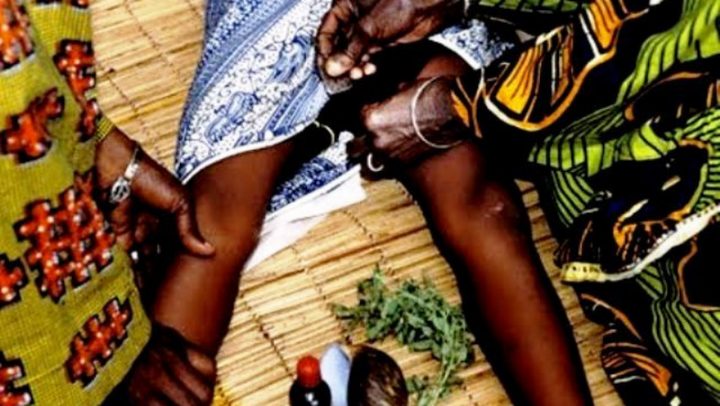Female Genital Mutilation (FGM) involves the partial or total removal of the external female genitalia or other injury to the female genital organs for non-medical reasons.
It is classified by experts into four major types, namely:
Type 1 is the partial or total removal of the glans clitoris (the external and visible part of the clitoris, which is a sensitive part of the female genitals), and/or the prepuce/ clitoral hood (the fold of skin surrounding the clitoris).
Type 2 is the partial or total removal of the glans clitoris and the labia minora (the inner folds of the vulva), with or without removal of the labia majora (the outer folds of skin of the vulva ).
Type 3, also known as infibulation, is the narrowing of the vaginal opening through the creation of a covering seal, where the seal is formed by cutting and repositioning the labia minora, or labia majora, sometimes through stitching, with or without removal of the clitoral hood and glans.
Type 4 includes all other harmful procedures to the female genitalia for non-medical purposes, e.g. pricking, piercing, incising, scrapping and cauterising the genital.
Societies and communities around the globe practice the different types of FGM, claiming it is a panacea for promiscuity and means of protecting women’s chastity.
It is prevalent in about 28 countries in Africa and few scattered communities globally. But its burden is seen in Nigeria, Egypt, Mali, Eritrea, Sudan, Central African Republic and Northern part of Ghana, where it has been an old traditional and cultural practice.
In Nigeria, the 2018 Nigeria and Demographic Health Survey (NDHS) report shows that the practice is prevalent in the South-South with 77 per cent, followed by South East with 68 per cent, South West with 65 per cent, but practiced on a smaller scale in the North.
However, it is recognised internationally as a violation of the right of girls and women, as experts conclude that it is a harmful practice and has no health benefits.
Global campaign against it is celebrated annually on May 23 as World Fistula Day to bring to the fore, the many disadvantages and ills of the practice and how it affects women and girls, as well as proffer solution to remedy the situation.
The theme of the 2020 edition is “End Gender Inequality! End Health Inequities! End Fistula now!”.
Dr Yeti Kunle of University of Port Harcourt Teaching Hospital, listed the numerous complications of FGM as severe pain, excessive bleeding (haemorrhage), genital tissue swelling, fever, infection, urinary problems, wound healing problems, injury to surrounding genital tissue, shock, and even death.
According to her, long-term complications can include urinary problems (painful urination, urinary tract infections, vaginal problems (discharge, itching, bacterial vaginosis and other infections); menstrual problems (painful menstruation, difficulty in passing menstrual blood), and many more.
For Dr Juliet Ofor, a medical practitioner with Federal Medical Centre, Jabi, Abuja “the act is a reflection of deep-rooted inequality between the sexes, and constitutes extreme form of discrimination against women.”
Ofor said it is carried out on minors, making it a violation of the rights of children.
The practice is a total violation of a person’s right to health, security and physical integrity; the right to be free from torture and inhuman or degrading treatment, and the right to life when the procedure results to death.
The medical practitioner, who emphasised the need for national and international legislation against FGM, said it has no health benefits but harm.
He noted that deinfibulation, a surgical procedure carried out to re-open the vaginal introitus of women living with type III FGM, is often necessary for improved health and well-being, as well as to allow intercourse or to facilitate childbirth.
She adds that “FGM has no health benefits, it harms girls and women in many ways. It involves removing and damaging healthy and normal female genital tissue, and interferes with the natural functions of girls’ and women’s bodies.
“The risks of FGM increase with increasing severity, which corresponds to the amount of tissue damaged, although all forms of FGM are associated with increased health risk.”
“It is clear that prevalence rates progressively decline in the young age groups and about 37 per cent of circumcised women do not want it to continue.”
Ofor urges government at all levels to begin massive sensitisation and education on the ills of FGM, noting, however, that “states like Ebonyi, Osun and Imo, where the practice is high, have, however, recorded reduction.
“But there is need for continuous education of the masses on the harmful cultural practice. Many stakeholders have consistently called on health workers to organise programmes on the harmful effects of FGM in rural areas, where it is seen as a cultural right, using local languages and citing examples of the complications.”
Adaku Okadigbo, an Abuja resident who said she was a victim of FGM, described the practice as a silent killer.
She said the destructive effects of FGM on her are so many to mention “and I will never practice it on my children or encourage any of my relatives or friends to do it on their girl children.”
She added that the practice is just to dehumanise the victims and not a panacea against promiscuity “because a promiscuous woman will still do it no matter what you do to her.”
Therefore, a Lecturer at Angel Crown College of Education, Abuja, Mrs Sylvia Oguamanam, emphasised the need for change of traditional and cultural ideology in target communities.
Oguamanam, who said there was considerable support for the practice in areas where it’s deeply rooted in local tradition and ignorance, noted that traditional rulers must be involved as major stakeholders to achieve the desired change.
NAN

